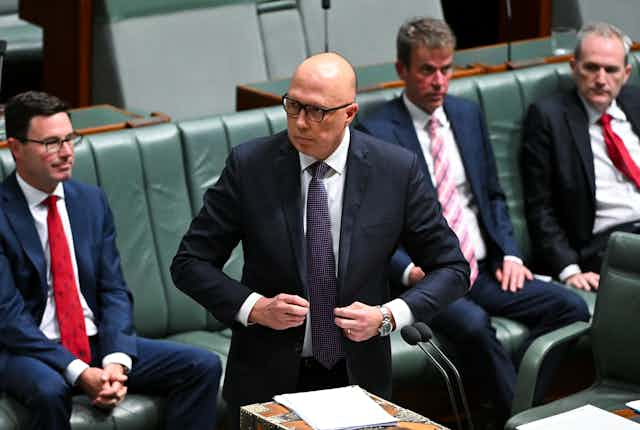Opposition Leader Peter Dutton has committed to holding another referendum on Indigenous constitutional recognition (without a Voice to Parliament), if the upcoming Voice referendum fails.
What does history tell us about the repeat of referendums on the same or similar subjects?
Hope springs eternal for a government that wants more power
In the first half of the 20th century, Commonwealth governments tended to bring referendums that sought to expand Commonwealth legislative power over commercial and industrial matters.
This included holding referendums on:
- trade and commerce in 1911, 1913 and 1919
- corporations in 1911, 1913, 1919, 1926 and 1944
- monopolies in 1911, 1913, 1919 and 1944
- trusts in 1913, 1919, 1926 and 1944
- marketing in 1937, 1944 and 1946
- industrial relations in 1911, 1913, 1919 and 1946.
In some cases, the referendums were intended to be temporary measures for postwar reconstruction. But regardless of the context, all these referendums failed. They even failed when they had bipartisan support. This was usually because they were opposed by state premiers or affected groups, such as unions, primary producers and business organisations.
Amendments about political arrangements rarely win
In the second half of the 20th century, referendums tended to focus more on political and voting arrangements.
For example, there were referendums to require simultaneous elections for the Senate and the House of Representatives in 1974, 1977, 1984 and 1988. Improving the fairness of elections was also put to referendums in 1974 and 1988.
The constitutional recognition of local government was considered in referendums in 1974 and 1988, and almost went to a third referendum in 2013, before it was pulled by then prime minister Kevin Rudd.
All of these referendums also failed. It seems Australian voters are not only suspicious about giving the Commonwealth parliament greater powers, but are also wary about altering the political and electoral rules set out in the Constitution.
Read more: Australians will vote in a referendum on October 14. What do you need to know?
The rare cases where a second go succeeds
The one case that bucked the trend was the amendment of the referendum process itself.
In 1901, there were no Commonwealth territories. So when the Constitution was passed, it provided that a referendum had to be put to voters in each state and would succeed when it was approved by a majority of voters nationally and a majority of voters in a majority of states.
This meant that when the Northern Territory and the Australian Capital Territory were established, their electors could not vote in federal referendums at all.
In 1974, a referendum proposed to change this, so residents in the territories would be counted in the overall national vote in a referendum. But this referendum question also proposed to alter the majority requirement, so that success was only needed in half of the states (three out of six), rather than a majority of states (four out of six).
The referendum failed. It was most strongly opposed in the least populous states.
In 1977, there was a second attempt, but this time it only proposed giving territorians the right to vote in a referendum and be counted in the overall majority. It succeeded in every state and overall.
So, it is possible to alter the terms of a failed referendum and achieve success – but it is very rare.
Another example goes back to federation itself. In 1898, referendums were held in New South Wales, Victoria, South Australia and Tasmania to approve federation. But while the NSW referendum achieved a majority, it did not meet the threshold requirement of 80,000 “yes” votes that was set out in the legislation for the referendum to succeed.
As there was no compulsory voting in those days, a minimum threshold had been put in place to ensure federation did not occur as a result of the votes of a small minority of those enfranchised.
But the vote was enough to tell the politicians that the voters actually wanted federation. This caused them to meet in a premiers’ conference in January 1899 to make some tweaks to the draft Constitution, including a compromise requiring Australia’s capital to be in NSW, but at least 100 miles from Sydney – which is how we got Canberra.
When a fresh referendum was held in June 1899, it succeeded, with a “yes” vote of 107,420 against a “no” vote of 82,741. The other states then also approved federation, and the Constitution was enacted by the British Parliament.
The factors needed for success
While most “second runs” of referendums fail, it is possible to succeed if the referendum proposal is altered or untethered from an unpopular element. The key factor in success, however, is having no organised group that opposes it. Bipartisan support at the Commonwealth level is therefore extremely important, as is support at the state level.
For example, the 1928 referendum on financial agreements between the Commonwealth and states succeeded, despite containing a radical clause that allowed these agreements to override state and federal laws and the Constitution itself.
It succeeded because the terms of the amendment had already been agreed to by every state parliament, as well as both sides in the Commonwealth parliament, before being put to the people. There had been an awful lot of advance groundwork done, so voters could be reassured by all sides and all levels of government that the amendment was safe and sensible.
But it is also important to capture the support of those who are particularly affected by the referendum, as any concerted campaign of opposition is likely to sow enough doubt to cause defeat. In the past, campaigns by religious organisations, unions, employers and primary producers have sunk referendum proposals.
If a second referendum were to be held on the recognition of Aboriginal and Torres Strait Islander peoples in the Constitution, substantial support by Indigenous Australians would be essential for its success.

